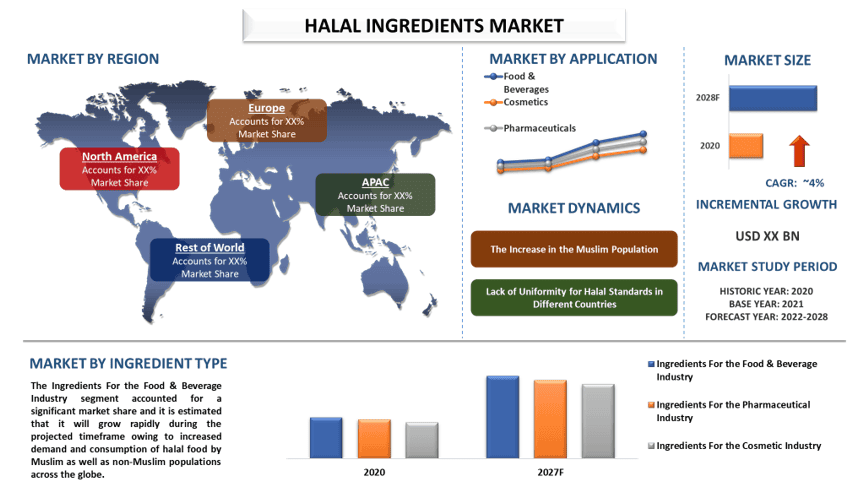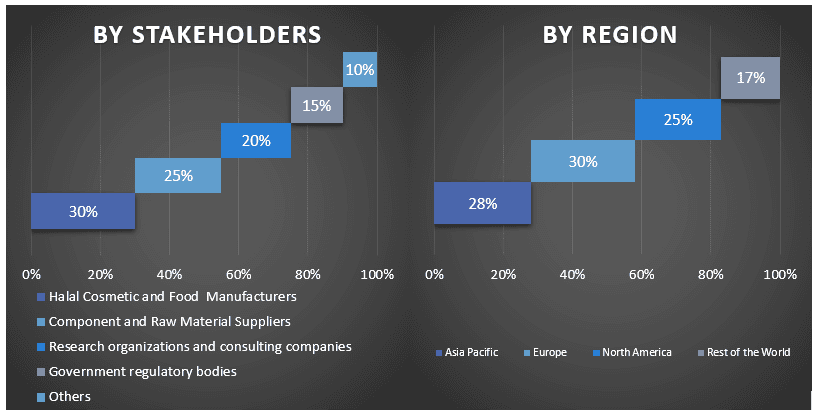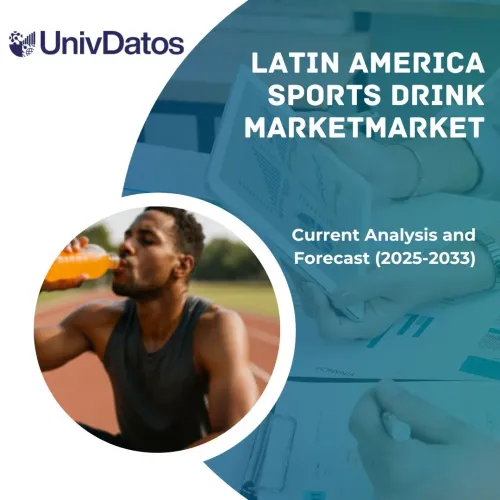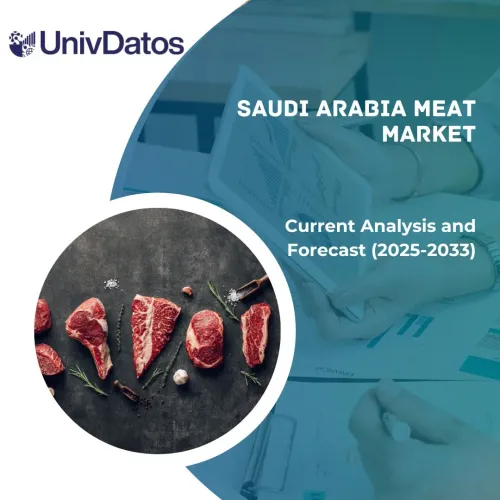Рынок халяльных ингредиентов: текущий анализ и прогноз (2022-2028 гг.)
Упор на типы ингредиентов (ингредиенты для пищевой промышленности и производства напитков, ингредиенты для фармацевтической промышленности, ингредиенты для косметической промышленности); Применение (продукты питания и напитки, косметика, фармацевтика); и Регион/Страна

Ожидается, что рынок халяльных ингредиентов будет регистрировать среднегодовой темп роста (CAGR) примерно 4% в период с 2022 по 2028 год. Халяльные ингредиенты - это те, которые разрешены исламским правом для использования в производстве различных продуктов. Халяль раньше был термином, зарезервированным только для членов исламской веры, но со временем он стал означать все, что является допустимым. Халяльные продукты в последнее время стали синонимом здоровых, свежих и чистых продуктов, что способствует их рыночному спросу. Растущий спрос на халяльные ингредиенты можно объяснить ростом мусульманского населения по всему миру. Например, согласно World Population Review, в 2022 году страной с наибольшим количеством мусульман является Индонезия, в которой проживает около 231 миллиона мусульман, то есть 86,7% населения Индонезии и почти 13% от общей численности мусульманского населения мира. В связи с явным ростом статистики численности мусульманского населения также увеличивается потребление халяльных продуктов питания во всем мире, что приводит к росту спроса на халяльные ингредиенты и будет способствовать росту рынка и в будущем. Кроме того, ожидается, что рынок халяльных ингредиентов будет расти за счет повышения осведомленности о функциональных продуктах питания и напитках, а также изменения потребительских предпочтений. Однако некоторые из ограничений на рынке, включая отсутствие единообразия стандартов халяль в разных странах, сдерживают рост этого рынка во всем мире.
Koninklijke DSM N.V., Cargill Inc, Barentz B.V., Archer-Daniels-Midland Co, Kerry Group PLC, Amara Beauty, Symrise, Nestle Private Limited, BRF SA, Del Monte Philippines Inc являются одними из ключевых игроков на рынке. Этими игроками предпринято несколько M&As, а также партнерств для предоставления клиентам высокотехнологичных и инновационных продуктов/технологий.
Аналитические выводы, представленные в отчете
“Среди типов ингредиентов, ингредиенты для пищевой промышленности и производства напитков занимали значительную долю на рынке в 2020 году”
Основываясь на типах ингредиентов, рынок халяльных ингредиентов сегментирован на ингредиенты для пищевой промышленности и производства напитков, ингредиенты для фармацевтической промышленности и ингредиенты для косметической промышленности. Сегмент ингредиентов для пищевой промышленности и производства напитков занимал значительную долю рынка, и, по оценкам, он будет быстро расти в течение прогнозируемого периода из-за увеличения спроса и потребления халяльной пищи как мусульманским, так и немусульманским населением по всему миру. Внедрение новых вкусов в отрасль как здоровых, чтобы сохранить продукты с халяльными ингредиентами в моде в течение более длительного периода времени, в основном привлекло молодое поколение, которое предпочитает быстрые закуски, а не полноценные блюда с надлежащим основным курсом. Фактор получения сертификата Халяль стал очень важным для того, чтобы доказать стандартизацию продукции потребителям.
“Среди областей применения, ожидается, что категория продуктов питания и напитков станет свидетелем значительного CAGR в течение прогнозируемого периода”
На основе применения рынок разделен на продукты питания и напитки, косметику и фармацевтику. Сегмент продуктов питания и напитков занял значительную долю рынка, и ожидается, что он будет расти со значительным среднегодовым темпом роста в течение прогнозируемого периода. Пищевые компании сосредотачиваются на инновациях в продуктах и предоставляют халяльные продукты для удовлетворения растущего спроса среди потребителей. Ожидается, что производство халяльных обработанных пищевых продуктов производителями и их усиливающееся потребление еще больше увеличат рост рынка халяльных ингредиентов.
“Ближний Восток станет свидетелем значительного роста в течение прогнозируемого периода”
Для лучшего понимания динамики рынка халяльных ингредиентов был проведен подробный анализ различных регионов мира, включая Северную Америку (США, Канаду и остальную часть Северной Америки), Европу (Германия, Франция, Испания, Великобритания, Италия и остальную часть Европы), Азиатско-Тихоокеанский регион (Китай, Индия, Австралия, Япония и остальную часть Азиатско-Тихоокеанского региона), Ближний Восток (Саудовская Аравия, Катар, Кувейт, ОАЭ, Бахрейн, Оман, остальную часть Ближнего Востока). Ближний Восток представляет собой крупный рынок для индустрии халяльных ингредиентов из-за благоприятного государственного регулирования в странах ССАГПЗ в отношении халяльной пищи, растущего населения в странах Ближнего Востока и быстрого экономического роста.
Причины для покупки этого отчета:
- Исследование включает анализ размера рынка и прогнозирования, подтвержденный аутентифицированными ключевыми экспертами отрасли.
- Отчет представляет собой быстрый обзор общих показателей отрасли с первого взгляда.
- Отчет охватывает углубленный анализ выдающихся отраслевых аналогов с уделением особого внимания ключевым финансовым показателям бизнеса, портфелю продуктов, стратегиям расширения и последним разработкам.
- Подробное изучение драйверов, ограничений, ключевых тенденций и возможностей, преобладающих в отрасли.
- Исследование всесторонне охватывает рынок по различным сегментам.
- Глубокий анализ отрасли на региональном уровне.
Варианты настройки:
Глобальный рынок халяльных ингредиентов может быть дополнительно настроен в соответствии с требованиями или любым другим сегментом рынка. Кроме того, UMI понимает, что у вас могут быть свои собственные потребности бизнеса, поэтому не стесняйтесь обращаться к нам, чтобы получить отчет, который полностью соответствует вашим требованиям.
Содержание
Методология исследования для анализа глобального рынка халяльных ингредиентов (2022-2028 гг.)
Анализ исторического рынка, оценка текущего рынка и прогнозирование будущего рынка глобального рынка халяльных ингредиентов были тремя основными шагами, предпринятыми для создания и анализа внедрения халяльных ингредиентов в основных регионах мира. Было проведено исчерпывающее вторичное исследование для сбора исторических данных о рынке и оценки текущего размера рынка. Во-вторых, для подтверждения этих выводов было принято во внимание множество результатов и предположений. Кроме того, были проведены исчерпывающие первичные интервью с отраслевыми экспертами по всей цепочке создания стоимости глобального рынка халяльных ингредиентов. После принятия и подтверждения рыночных показателей посредством первичных интервью мы применили нисходящий/восходящий подход к прогнозированию полного размера рынка. После этого были приняты методы разбивки рынка и триангуляции данных для оценки и анализа размера рынка сегментов и подсегментов, к которым относится отрасль. Подробная методология описана ниже:
Анализ исторического размера рынка
Шаг 1: Углубленное изучение вторичных источников:
Было проведено подробное вторичное исследование для получения исторических данных о размере рынка халяльных ингредиентов из внутренних источников компании, таких как годовой отчет и финансовая отчетность, презентации результатов деятельности, пресс-релизы и т. д., и внешних источников, включая журналы, новости и статьи, правительственные публикации, публикации конкурентов, отраслевые отчеты, сторонние базы данных и другие надежные публикации.
Шаг 2: Сегментация рынка:
После получения исторических данных о размере рынка халяльных ингредиентов мы провели подробный вторичный анализ для сбора исторических данных о рынке и долях различных сегментов и подсегментов для основных регионов. Основные сегменты, включенные в отчет, включают тип ингредиента и применение. Был проведен дальнейший анализ на уровне страны для оценки общего внедрения моделей тестирования в этом регионе.
Шаг 3: Факторный анализ:
После получения исторических данных о размере рынка различных сегментов и подсегментов мы провели подробный факторный анализ для оценки текущего размера рынка халяльных ингредиентов. Кроме того, мы провели факторный анализ с использованием зависимых и независимых переменных, таких как рост потребления халяльной пищи мусульманскими и немусульманскими группами во всем мире. Был проведен тщательный анализ сценариев спроса и предложения с учетом ведущих партнерств, слияний и поглощений, расширения бизнеса и запуска продуктов в секторе рынка халяльных ингредиентов по всему миру.
Оценка и прогноз текущего размера рынка
Определение текущего размера рынка: На основе практически полезных выводов, полученных из вышеуказанных 3 шагов, мы определили текущий размер рынка, ключевых игроков на глобальном рынке халяльных ингредиентов и доли рынка сегментов. Все необходимые процентные доли и разбивки рынка были определены с использованием вышеупомянутого вторичного подхода и были проверены посредством первичных интервью.
Оценка и прогнозирование: Для оценки и прогнозирования рынка различным факторам были присвоены веса, включая драйверы и тенденции, ограничения и возможности, доступные для заинтересованных сторон. После анализа этих факторов были применены соответствующие методы прогнозирования, т.е. восходящий/нисходящий подход, чтобы прийти к прогнозу рынка примерно на 2028 год для различных сегментов и подсегментов на основных рынках по всему миру. Методология исследования, принятая для оценки размера рынка, включает в себя:
- Размер рынка отрасли с точки зрения выручки (доллары США) и темпы внедрения рынка халяльных ингредиентов на основных рынках внутри страны
- Все процентные доли, разбивки и разбивки рыночных сегментов и подсегментов
- Ключевые игроки на глобальном рынке халяльных ингредиентов с точки зрения предлагаемых решений. Кроме того, стратегии роста, принятые этими игроками для конкуренции на быстрорастущем рынке
Подтверждение размера и доли рынка
Первичное исследование: Были проведены углубленные интервью с ключевыми лидерами мнений (KOL), включая руководителей высшего звена (CXO/вице-президенты, руководители отделов продаж, руководители отделов маркетинга, руководители операционных отделов и региональные руководители, руководители стран и т. д.) в основных регионах. Затем были обобщены результаты первичного исследования и проведен статистический анализ для доказательства заявленной гипотезы. Входные данные первичного исследования были объединены с результатами вторичного исследования, превращая тем самым информацию в практически полезные выводы.
Разбивка первичных участников по различным регионам

Инженерия рынка
Метод триангуляции данных был использован для завершения общей оценки рынка и получения точных статистических данных по каждому сегменту и подсегменту глобального рынка халяльных ингредиентов. Данные были разделены на несколько сегментов и подсегментов после изучения различных параметров и тенденций в областях типа ингредиентов и применения на глобальном рынке халяльных ингредиентов.
Основная цель исследования глобального рынка халяльных ингредиентов
В исследовании были точно определены текущие и будущие тенденции рынка глобального рынка халяльных ингредиентов. Инвесторы могут получить стратегическое понимание, чтобы основывать свои решения для инвестиций на качественном и количественном анализе, проведенном в исследовании. Текущие и будущие тенденции рынка определили общую привлекательность рынка на региональном уровне, предоставив промышленному участнику платформу для использования неиспользованного рынка, чтобы получить выгоду в качестве преимущества первопроходца. Другие количественные цели исследований включают:
- Анализ текущего и прогнозируемого размера рынка халяльных ингредиентов с точки зрения стоимости (доллары США). Кроме того, проанализируйте текущий и прогнозируемый размер рынка различных сегментов и подсегментов
- Сегменты в исследовании включают области типа ингредиентов и применения.
- Определение и анализ нормативно-правовой базы для индустрии рынка халяльных ингредиентов.
- Анализ цепочки создания стоимости с участием различных посредников, а также анализ поведения клиентов и конкурентов отрасли.
- Проанализируйте текущий и прогнозируемый размер рынка халяльных ингредиентов для основного региона.
- Основные страны регионов, изученные в отчете, включают Азиатско-Тихоокеанский регион, Европу, Северную Америку и Ближний Восток.
- Профили компаний рынка халяльных ингредиентов и стратегии роста, принятые участниками рынка для поддержания устойчивости на быстрорастущем рынке
- Углубленный анализ отрасли на региональном уровне
Связанные Отчеты
Клиенты, купившие этот товар, также купили










